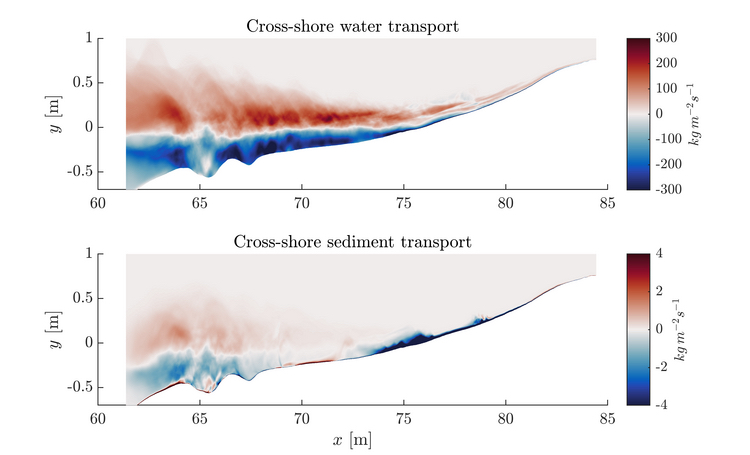J.W.M. Kranenborg1*, G.H.P. Campmans1, J.J. van der Werf1,2, N.G. Jacobsen3, R. McCall2, A.J.H.M. Reniers4, S.J.M.H Hulscher1
1 University of Twente
2 Deltares
3 Vattenfall AB
4 Delft University of Technology
*corresponding author:
Introduction
Most models used to study the morphodynamics in the swash-zone are based on a depth-averaged approach (e.g. XBeach). However, such models have difficulties in reproducing the complex dynamics in the swash zone, such as the overturning shape of a breaking wave, or the depth-dependency of the suspended sediment flux. Depth-resolving models, although being computationally more expensive, do not have these inherent drawbacks, and thus they are useful tools to better understand such processes. The knowledge these models provide could subsequently be fed back to improve the faster depth-averaged models.
Model study
In this study, we present our initial findings of a depth-resolving model for hydrodynamics and sediment transport, based on the Reynolds Averaged Navier-Stokes (RANS) equations (implemented in OpenFoam). These findings use an extended version of the model by Jacobsen et al., (2012) and is applied to the laboratory experiments of van der Zanden et al., (2019). These experiments feature bichromatic waves which repeat every two wave-groups, and with a wave height of H=0.6 m. Figure 1 shows the cross-shore water and sediment fluxes, averaged over four wave groups. These results show a clear vertical dependency in both the sediment and water fluxes. Furthermore, at certain cross-shore locations, the near-bed sediment flux direction is opposite to that of the water flux (e.g. at x = 70 m). At the conference, we will show the demonstrate the use of depth-resolving models, and the importance of these vertical structures for the swash zone sediment transport.

Figure 1: Cross-shore water and sediment fluxes averaged over four wave groups. Here red means onshore transport and blue means offshore transport.
References
Jacobsen, N. G., Fredsoe, J., and Jensen, J. H. (2014). Formation and development of a breaker bar under regular waves. part 1: Model description and hydrodynamics. Coastal Engineering, 88:182 – 19
van der Zanden, J., Cáceres, I., Eichentopf, S., Ribberink, S.J., van der Werf, J.J., Alsina, J.M. (2019). Sand transport processes and bed level changes induced by two alternating laboratory swash events. Coastal Engineering, 152
I. Surname1*, F.N. Another-Surname2 , Y. Next-Surname2
1 University Name, Country; 2 Organization Name, Country
* Corresponding author: mail.name@organization.org


